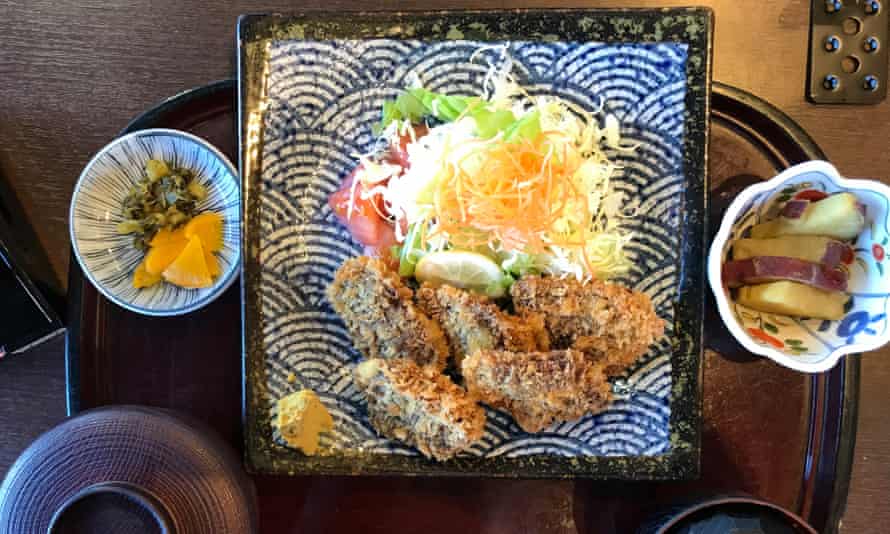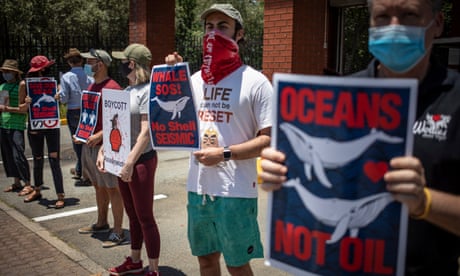The resumption of killing whales for profit for the first time in over 30 years is offering little cause for celebration

Fisheries workers butcher a Baird's beaked whale in Wada. Photograph: Justin McCurry
Justin McCurry in Wada
Sun 26 Dec 2021
You don’t have to look far to find evidence of Wada’s centuries-old connection to whaling. Visitors to the town on Japan’s Pacific coast are greeted by a replica skeleton of a blue whale before entering a museum devoted to the behemoths of the ocean.
At a local restaurant, diners eat deep-fried whale cutlet and buy cetacean-themed gifts at a neighbouring gift shop. At the edge of the water stands a wooden deck where harpooned whales are butchered before being sold to wholesalers and restaurants.
In 2019, when Japan withdrew from the International Whaling Commission (IWC) – the body that had effectively banned whaling in the late 1980s – Wada rejoiced at the prospect of a return to commercial hunting and at a popular reconnection with a source of food that had sustained coastal communities for 400 years.
Advertisement
But here and in other whaling towns in Japan, the resumption of killing whales for profit for the first time in more than three decades has offered little cause for celebration.
While condemnation from conservation groups has eased in the three years since Japan’s fleet exited the Antarctic, the country’s whalers face other obstacles: ageing fishermen and vessels, mysterious changes in cetacean behaviour possibly linked to climate change, and a stubborn refusal among Japanese people to eat enough whale meat to make killing them a profitable venture.
While Japan skirted the IWC ban by conducting limited “scientific” hunts in the Antarctic, it had long argued that only a return to commercial whaling would guarantee a stable supply of affordable meat and ignite a revival in consumption.
“But all the evidence points in the opposite direction,” says Patrick Ramage, senior director for outreach and programme collaboration at the International Fund for Animal Welfare. “Whether pursued on the high seas under the pretext of science or in coastal waters in pursuit of profit, Japan’s commercial whaling is an economic loser, kept afloat only by government subsidies.”
Ramage believes the future of Japan’s ageing whaling towns rests on embracing ecotourism. “Whale-watching is making growing contributions to local economies around the world, particularly in locations previously involved in whaling. It’s better to have tourists paying to see whales than taxpayers paying to keep whaling on life support.”

Justin McCurry in Wada
Sun 26 Dec 2021
You don’t have to look far to find evidence of Wada’s centuries-old connection to whaling. Visitors to the town on Japan’s Pacific coast are greeted by a replica skeleton of a blue whale before entering a museum devoted to the behemoths of the ocean.
At a local restaurant, diners eat deep-fried whale cutlet and buy cetacean-themed gifts at a neighbouring gift shop. At the edge of the water stands a wooden deck where harpooned whales are butchered before being sold to wholesalers and restaurants.
In 2019, when Japan withdrew from the International Whaling Commission (IWC) – the body that had effectively banned whaling in the late 1980s – Wada rejoiced at the prospect of a return to commercial hunting and at a popular reconnection with a source of food that had sustained coastal communities for 400 years.
Advertisement
But here and in other whaling towns in Japan, the resumption of killing whales for profit for the first time in more than three decades has offered little cause for celebration.
While condemnation from conservation groups has eased in the three years since Japan’s fleet exited the Antarctic, the country’s whalers face other obstacles: ageing fishermen and vessels, mysterious changes in cetacean behaviour possibly linked to climate change, and a stubborn refusal among Japanese people to eat enough whale meat to make killing them a profitable venture.
While Japan skirted the IWC ban by conducting limited “scientific” hunts in the Antarctic, it had long argued that only a return to commercial whaling would guarantee a stable supply of affordable meat and ignite a revival in consumption.
“But all the evidence points in the opposite direction,” says Patrick Ramage, senior director for outreach and programme collaboration at the International Fund for Animal Welfare. “Whether pursued on the high seas under the pretext of science or in coastal waters in pursuit of profit, Japan’s commercial whaling is an economic loser, kept afloat only by government subsidies.”
Ramage believes the future of Japan’s ageing whaling towns rests on embracing ecotourism. “Whale-watching is making growing contributions to local economies around the world, particularly in locations previously involved in whaling. It’s better to have tourists paying to see whales than taxpayers paying to keep whaling on life support.”

Deep-fried whale meat cutlets at a restaurant in Wada. Photograph: Justin McCurry
Barely 300 people in Japan are directly connected to whaling, while whale made up only about 0.1% of the country’s total meat consumption in 2016, according to government data. About 4-5,000 tonnes of whale meat enter the domestic market every year – the equivalent in volume of about half an apple for every person.
But Yoshinori Shoji, the president of the Gaibo Hogei, a whaling company in Wada, said abandoning coastal hunting was unthinkable. “I know it is controversial in other parts of the world, but for us, whales are simply a source of food,” said Shoji, whose company has been processing whale meat for more than 70 years.
To keep the town’s whaling culture alive, whale meat is served twice a year at local primary schools and children are invited to watch workers flense Baird’s beaked whales after they have been harpooned and dragged ashore, where they are left intact for 18 hours to allow their meat to mature.
“Why shouldn’t we eat whale meat?” says Shoji. “Humans have always eaten local wildlife. It depends on the surrounding environment. My job is to give people the chance to eat and appreciate locally caught whale meat. We’re not forcing anyone to eat it.”
He displays hunks of frozen meat and blubber, some of which is sent to Japan’s north-east coast where it is made into soup. On the roof of his factory, slices of Baird’s beaked whale blacken beneath the winter sun before being sold as a local delicacy reminiscent of beef jerky.

Shell to go ahead with seismic tests in whale breeding grounds after court win
But Wada’s 30 whale-industry employees are struggling. During last year’s April-October season, they caught just nine whales and have harpooned the same number so far this year. Shoji believes warmer seas may have sent the whales farther north, while more frequent powerful typhoons have confined the town’s two whaling boats to port for days on end.
Japan’s commercial whaling industry would grind to a halt without government subsidies of ¥5.1bn (£.033bn) a year, says Junko Sakuma, a freelance journalist and expert on Japan’s whaling economy.
“The government has said that it can’t continue to subside what is supposed to be a commercial concern for ever,” she says. “When Japan left the IWC, fisheries officials thought they would be able to catch as many whales as they needed to sustain the industry, but in fact it has shrunk. Japanese whaling will continue, but in a much smaller form.”
Paradoxically, the end of “scientific” whaling and the Japanese fleet’s annual clashes with the anti-whaling organisation Sea Shepherd may be hastening whaling’s decline. “In the past, Japanese people were defensive because they didn’t like white people telling them not to eat whale meat,” Sakuma says. “But whaling is barely mentioned these days by anti-whaling countries like Australia, Britain and the US. Now Japanese people have nothing to rebel against, so they could end up just forgetting about whale meat.”
Barely 300 people in Japan are directly connected to whaling, while whale made up only about 0.1% of the country’s total meat consumption in 2016, according to government data. About 4-5,000 tonnes of whale meat enter the domestic market every year – the equivalent in volume of about half an apple for every person.
But Yoshinori Shoji, the president of the Gaibo Hogei, a whaling company in Wada, said abandoning coastal hunting was unthinkable. “I know it is controversial in other parts of the world, but for us, whales are simply a source of food,” said Shoji, whose company has been processing whale meat for more than 70 years.
To keep the town’s whaling culture alive, whale meat is served twice a year at local primary schools and children are invited to watch workers flense Baird’s beaked whales after they have been harpooned and dragged ashore, where they are left intact for 18 hours to allow their meat to mature.
“Why shouldn’t we eat whale meat?” says Shoji. “Humans have always eaten local wildlife. It depends on the surrounding environment. My job is to give people the chance to eat and appreciate locally caught whale meat. We’re not forcing anyone to eat it.”
He displays hunks of frozen meat and blubber, some of which is sent to Japan’s north-east coast where it is made into soup. On the roof of his factory, slices of Baird’s beaked whale blacken beneath the winter sun before being sold as a local delicacy reminiscent of beef jerky.

Shell to go ahead with seismic tests in whale breeding grounds after court win
But Wada’s 30 whale-industry employees are struggling. During last year’s April-October season, they caught just nine whales and have harpooned the same number so far this year. Shoji believes warmer seas may have sent the whales farther north, while more frequent powerful typhoons have confined the town’s two whaling boats to port for days on end.
Japan’s commercial whaling industry would grind to a halt without government subsidies of ¥5.1bn (£.033bn) a year, says Junko Sakuma, a freelance journalist and expert on Japan’s whaling economy.
“The government has said that it can’t continue to subside what is supposed to be a commercial concern for ever,” she says. “When Japan left the IWC, fisheries officials thought they would be able to catch as many whales as they needed to sustain the industry, but in fact it has shrunk. Japanese whaling will continue, but in a much smaller form.”
Paradoxically, the end of “scientific” whaling and the Japanese fleet’s annual clashes with the anti-whaling organisation Sea Shepherd may be hastening whaling’s decline. “In the past, Japanese people were defensive because they didn’t like white people telling them not to eat whale meat,” Sakuma says. “But whaling is barely mentioned these days by anti-whaling countries like Australia, Britain and the US. Now Japanese people have nothing to rebel against, so they could end up just forgetting about whale meat.”
No comments:
Post a Comment